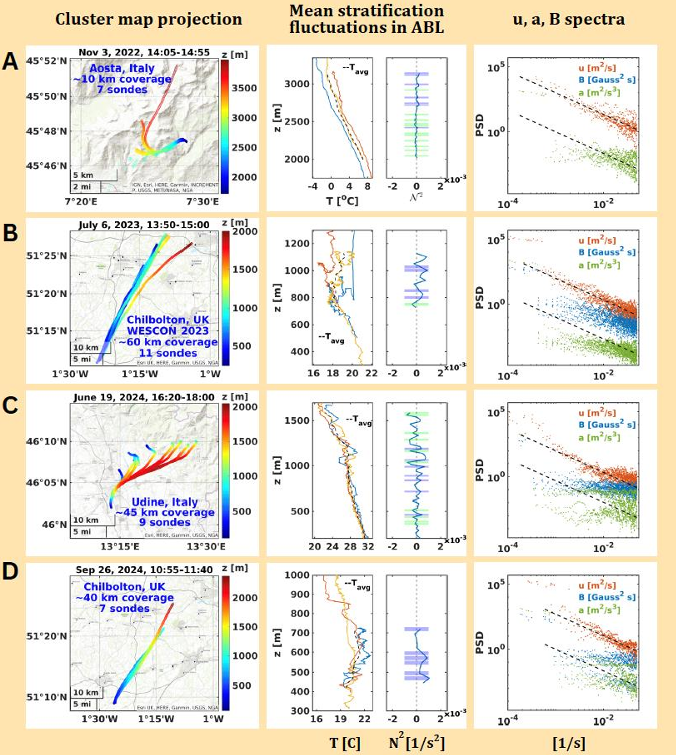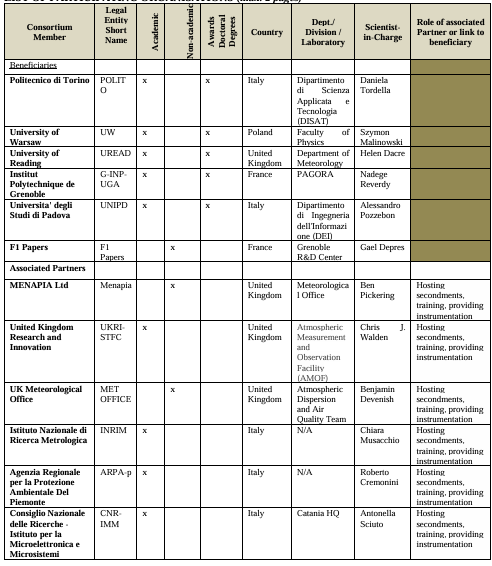29 Jan BALLANSE: MARIE SKŁODOWSKA-CURIE ACTIONS
BALLANSE
Introduction, objectives and overview of the research programme
BALLANSE puts forth a novel platform for Lagrangian observation of the Atmospheric Boundary Layer to be implemented in synergy between Meteorological Observatories, Numerical Weather Prediction, Clusters of air-floating Biodegradable Radiosondes. The atmosphere in the layers close to the Earth’s surface, comprising vast plains, heterogeneous and complex terrain, alpine regions, coastal regions of seas and ocean basins, is largely described by the exchange and transport processes occurring within the atmospheric boundary layer (ABL) and the warm cloud formations contained therein. These processes are driven by the turbulence occurring on a wide range of scales. It is of the utmost importance that these processes are adequately parameterised in numerical weather prediction (NWP) models to ensure the high predictive skill of forecasts. For instance, it has been widely understood that simplifying turbulence to statistical models may not apply. One reason for the current lack of understanding of the ABL and related warm cloud formation and microphysics is the challenge of adequately observing and sampling their spatio-temporal structure. In this regard, the Lagrangian particle-based approach is an advanced technique to either model and/or directly infer the ABL turbulent dispersion and its coupling to cloud microphysics. The Lagrangian particle-based approach is an advanced technique for modeling ABL turbulent dispersion and its coupling to cloud microphysics, offering advantages over traditional Eulerian methods. Notably, it enables direct investigation of mechanisms like the broadening of water droplet size distribution due to droplets following varied trajectories through regions of fluctuating supersaturation.).
In many studies, even those in which measurements are made solely at fixed locations, a Lagrangian approach is employed by tracing the origin of air masses reaching the surface station through the use of backward trajectories calculated using a model, namely the Hybrid Single Particle Lagrangian Integrated Trajectory (HSPLIT) model.2. These models adopt meteorological data from the Global Data Assimilation System (GDAS) with a given spatial resolution as the input.
The BALLANSE project will integrate observational data from Meteorological Observatory Infrastructures (surface in-situ instruments) with Lagrangian data obtained through an innovative method for tracking the trajectories of multiple observation points carried directly by ABL motions within the European mesoscale over a 24-30 h time window. Within BALLANSE, in fact, the ABL will be observed endoscopically by means of in-situ measurements made by a cluster of expendable green mini radiosondes floating passively and isopycnically within the first 4 km of the atmosphere. A series of physicochemical scalars (fluctuations in temperature, humidity, pressure, concentrations of volatile organics, UV radiation, supersaturation) and vector quantities (observation point locations, velocities, accelerations, and local Earth magnetic field (for estimating micro-lightning concentration)) will be measured. BALLANSE aligns with the global European Research Area (ERA) policy, the European Green Deal’s comprehensive strategy, and the UN’s Sustainable Develment Goals (SDGs 5,7,9,12,13,17, see Section 2.4.3 for target description).
BALLANSE radiosonde key breakthroughs
A) In contrast to standard radiosondes, aimed at vertical profiling of the atmosphere, BALLANSE mini radiosondes are designed rather for isopycnic floating in the air in order to track evolution of air parcels (air masses) moving with the flow.
B) Another special property of these radiosondes is ability to be launched and tracked in swarms, which makes them a precious tool to investigate Lagrangian dispersion in atmospheric micro- and mesoscale further distinctive feature of these radiosondes is their capacity to be deployed and tracked in swarms without the need for dedicated launching apparatus. This renders them an invaluable instrument for the study of Lagrangian dispersion in atmospheric micro- and mesoscale.
C) In the construction of the radiosondes an effort is undertaken to make them environmentally friendly. In particular, a biodegradable balloon material is being used. Furthermore, the electronic circuit board will be in part made by recyclable printed devices on paper (UHF dipole antennas, sensors for temperature, humidity, pressure, and batteries).
D) Lightweight (20 g), small size (PCB 3cmx3cm, balloon 40 cm) are the less intrusive device with respect to the airflow transporting it. The deployment of such radiosonde swarm is a very powerful new tool for large spatial and temporal scale atmospheric observation and measurement.
BALLANSE collects raw quantitative Lagrangian data on atmospheric dispersion and air quality in four different European mesoscale regions: the Atlantic rural mid-latitude, the Low-land central European plain, the Alpine environment, and the near sub-Arctic coastal region (see Table 1.1).

Table 1.1 In-field experimental campaigns
BALLANSE radiosonde clusters enable real-time detection of hazardous concentrations, supporting emergency services and industries in efficiently monitoring toxic and hazardous substances.
Developed from scratch in POLITO, a first prototype of a mini radiosonde cluster for sub-mesoscale observations is already operational and has been tested in different infield campaigns5, see Fig. 1.1. Lagrangian models for cloud microphysics have been recently developed and the impact of a new free tropospheric turbulence scheme on the dispersion of an atmospheric tracer has been recently analysed. For further details on the network achievements, see section 1.2 below. However, to achieve the objectives, it is important also to consider the availability of the excellent laboratories of UW, POLITO, G-INP, UGA, F1 Papers, UNIPD, CNR-IMM, INRIM, and MENAPIA, the world-class technology of the Eulerian meteorological observing facilities (UKRI-FTSC, Chilbolton Observatory, ACTRIS-ERIC Consortium), the transnational sustainable access through ATMO-ACCESS to many atmospheric observing facilities, the HPC supercomputers (UK JASMIN by STFC, UK national supercomputer ARCHER2, Cray XC40, PRACE Marconi100 and LEONARDO, by CINECA in Italy).

Figure 1.1 In-field experiments with the radiosonde cluster network
Figure 1.1 In-field experiments with the radiosonde cluster network. LoRa P2P radio transmission, nominal range 12 Km, 868 MHz, data acquisition frequency 0.2 Hz. Left column: radiosonde trajectories. Middle column: vertical profiles of temperature and mean Brunt-Vaisala frequency of subset of 3 radiosondes. The violet colour highlights the altitude ranges where all three profiles had a positive (stable) temperature gradient, while the green colour indicates where all three profiles had a negative (unstable) temperature gradient. Right column: wind speed, magnetic field (for the cases B, C, D) and acceleration fluctuation spectra. A) Alpine environment, St. Barthelemy, Aosta, Italy, November 2023. B) rural near-maritime Atlantic coast, Chilbolton, UK, July 2023, WESCON campaign. C) sub-Alpine region, Udine, Italy, June 2024. D), rural near-maritime Atlantic coast Chilbolton, UK, September 2024. Ground level wind speeds: A: 1 m/s, B: 17 m/s, C: 0.5 m/s, D: 10 m/s.
LIST OF PARTICIPATING ORGANISATIONS

Data for non-academic beneficiaries

Table 1.2. Main Network-Wide Training Events, Conferences and Contribution of Beneficiaries (invited speakers in bold)




